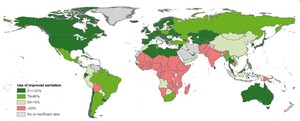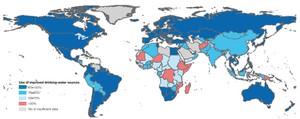As the previous sections have shown, providing WASH services brings many benefits. Unfortunately, however, the reality on the ground is that globally we are a long way from achieving these benefits for all people. Studies have shown that in many parts of the world, access to WASH services is still very low (Figures 1.5 and 1.6).

Figure 1.5 Percentage of population using improved sanitation facilities (data for 2008). (GLAAS, 2010)

Figure 1.6 Percentage of population obtaining drinking water from an improved source (data for 2008). (GLAAS, 2010)
Based on the 2008 data in Figures 1.5 and 1.6, what percentage of the population in Ethiopia used improved sanitation and what percentage got their drinking water from an improved source?
Less than 50% of Ethiopians used improved sanitation and less than 50% used an improved source for water.
Note that the data in Figures 1.5 and 1.6 is from 2008 and these numbers are changing quite rapidly. The situation is improving, but there is still a great challenge ahead. Data for 2012, the most recent available at the time of writing, indicates that in Ethiopia about 37% of the population are still practising open defecation (JMP, 2014a). In 1990 this figure was 92%, which indicates the significant change in the past 25 years but even with this improvement, the current situation is still appalling.
The first challenge facing the WASH sector in Ethiopia therefore is the scale of the problem. There needs to be a huge investment of time and money to design and build new infrastructure. The water supply system needs to be extended and be more reliable, with fewer breaks in service and less loss from leakage. Support services for the sector need to be improved to make it work effectively and sustainably. Monitoring needs to be increased so that breakdowns can be repaired in a timely manner. Regulations and enforcement should be stronger to protect the environment and human health. In addition there needs to be changes to the way projects are planned and implemented to overcome past difficulties. You have already learned about the problem of focusing on water supply in the majority of projects and missing the sanitation and hygiene components. There have been a number of other problems with past projects that have reduced their effectiveness. These problems include: